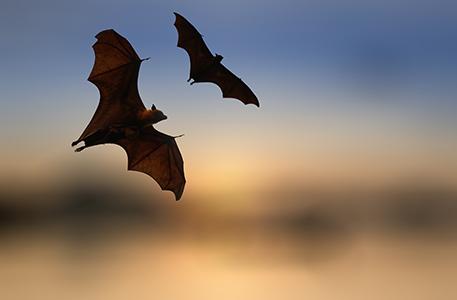
The Not-So-Spooky Benefits of Backyard Bats
Most people are afraid of bats. But once you become acquainted with these elusive creatures, you may encourage them to move into your yard! Here are five of the most frequently asked questions about these misunderstood mammals.
1. What are the primary benefits of bats?
Bats may not be the cutest animals, but are vital in maintaining healthy ecosystems. They help keep troublesome insect populations under control, are essential pollinators, and also help scientists monitor air quality.
Closer to home, bats can make several valuable contributions in your yard:
- Bats eat mosquitos. Lots of mosquitos! Imagine the pleasures of summer nights with fewer mosquitos!
- Bats also feast on pollen-carrying insects, helping improve air quality for allergy sufferers.
- Their poop (called guano) helps fertilize your lawn and your garden.
- Bats’ swooping dusk-to-dawn movements are entertaining.
Unfortunately, bats are losing habitat, and their existence is threatened in some locations. Providing shelter in your yard is one way to prevent them from declining further while enjoying their benefits.
2. Are bats dangerous?
No! Bats may be starring in scary Halloween tales, but they’re shy and intelligent creatures afraid of humans. They only attack insects! Bat-human collisions have indeed occurred, but that’s because people have accidentally crossed into a bat’s path while it’s hunting flying insects.
Bats are often associated with rabies, but just a tiny percentage of them die from the rabies virus. And all mammals can get rabies. For this reason, it’s best to avoid touching any wild animal with your bare hands.
What about histoplasmosis? There is a slight possibility that the fungus that causes this respiratory disease will grow in areas where the soil is highly enriched with bird or bat droppings.
However, most U.S. cases of histoplasmosis have occurred in the Ohio and Mississippi River valley regions, where warm, humid conditions tend to promote fungal growth, and most incidents are minor. If interested, learn more about histoplasmosis from the Centers for Disease Control and Prevention (CDC).
The bottom line is that given the extremely low risks posed by bats, they deserve considerably more credit for doing good than harm!
3. What’s the best location for a bat house?
Once you see bats in a better light, you might want to extend a welcome mat and position a bat house on your property. Unfortunately, there’s no way to guarantee bats will come live in your yard, but if you can meet these conditions, you’ll improve your results:
Elevated - Bats want a shelter that’s easy to fly in and out of but also high enough that critters like raccoons and cats can’t reach them. Two good options are a tall pole or the side of a building, at least 15 feet off the ground.
Safe from flying prey - Besides height above ground-dwelling predators, bat houses should be positioned at least 20 feet away from trees so owls and hawks can’t perch on the branches and quickly swoop in on bats entering or leaving their roost.
Warmth - Bats like heat, but not too much of it! Position your bat house for 6-8 hours of direct sun exposure, ideally facing southeast or southwest. You can also paint your bat house to retain more or less heat.
In most parts of the U.S., a medium shade of brown or grey is ideal. However, if your average daily temperature in July is below 85 degrees F, use a dark color to retain more heat, and if your July temps exceed 95 degrees F, stick to a lighter shade of paint.
Near water - Birds drink from bird baths, but bats drink while flying, swooping down on more significant water sources. So, you’re more likely to attract bats if a stream, pond, or other natural source of water is within a quarter mile of your property.
Avoid artificial light - Since bats are nocturnal, street lamps and yard lights will disturb their natural rhythms. Choose a location that remains shadowed at night.
4. Can you build a bat house?
Yes! It’s an easy DIY project, and you can find numerous articles and how-to videos online with various designs and materials. For general guidelines, check out these tips from Bat Conservation International.
It’s crucial to understand bat house basics so your box is more likely to attract bats—and to ensure it doesn’t have dangerous features like sharp nails or screw-tips exposed within the nesting compartments.
Even though the temps are slowly dropping, it’s an excellent time to build or buy your bat house so it’s ready when bats start setting up nests in the spring. Across many parts of the U.S., autumn is when bats migrate to warmer areas or prepare for winter hibernation.
5. How long do bats live?
Most small animals have short lifespans, but bats are unique and can easily live 20 to 30 years, depending on the species. The oldest known bat lived at least 41 years! So, if you’re fortunate enough to attract roosting bats to your bat house, you might enjoy some very long-term residents.
